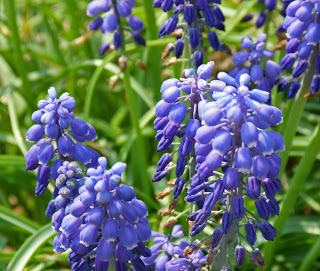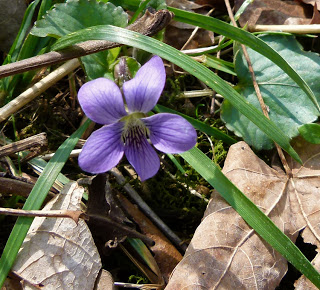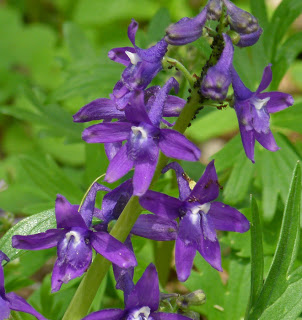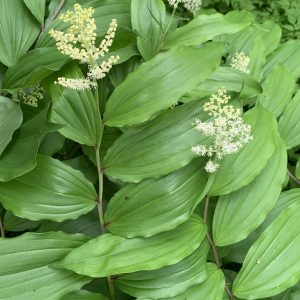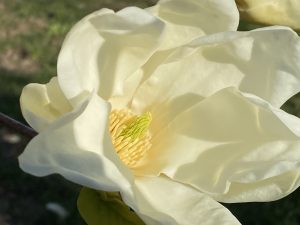“What in the world are all those purple flowers growing in that field?” When we drive along country fields that have not yet been sown in a crop, we often see patches of purple or purple-red flowers growing in them. (Deciding the correct color for wildflowers is an issue I intend to address in another post. For now, please indulge me in this.)
This field has, without a doubt, the darkest, purplest color growing in a large area I’ve ever seen! Assuming it to be a gigantic field of Violets, I pull the car to the side of the road and get out. In Texas, I saw fields this color, filled with Texas Bluebonnets.
Ohmigosh! They are Grape Hyacinths! I’ve never seen that many growing together in the wild! Tavia says they were introduced from Europe and thrive in abandoned lawns and waste places, after escaping from cultivation. Can’t you just hear them singing, “Free at last! Thank God, I’m free at last!”
This is the Purple Patch I find in suburban lawns where the residents refuse to pay a lawn service to kill their wildflowers. April 15 Tax Day is one of the best days to see these splendid gatherings of Common Violets.
When I was a Girl Scout we sang a song about Sweet Violets, sweeter than all the roses. Covered all over from head to toe, covered all over in sweet violets. Does anyone else remember that song? Tavia likes to eat them in salads and says they have loads of vitamin C.
Look at the first picture again. Abandoned or unplanted fields will also be covered in this reddish-purple flower growing close to the ground, and I’ve always been confused about what that might be. The most likely candidate is Purple Dead Nettle aka Red Dead Nettle, which is neither red, nor dead, nor a nettle at all! As you have guessed by now, it is an invasive from Eurasia, thriving in open areas, fields, lawns and waste places, and very difficult to remove once established. This genus has nettle-like leaves, but they lack the sting. The overlapping leaf and flower pattern somewhat resembles a Japanese pagoda. If you peer closely at the small flowers, they are quite lovely and delicate.
A flower similar to the Dead Nettle (well, it is to me at least, and very confusing) is the Henbit, another low to the ground plant with small, delicate purple blooms, found in the same open areas as the Dead Nettle. But look at the leaves on this plant. Notice the bare stem between the leaves, and the way they all cling to the stem. The small blossom points up as well.
The third weedy plant that I find to be confusing is Ground Ivy, or, as my mother-in-law said, Charlie Weed. This is the one that will cover your lawn and flower beds in long mats. You pull one end, and can find four feet of plant with a distinctive odor in your hand. Tavia notes that this species has been used to make ale, reportedly helping those who drank it to extend their lives, cure headaches, pains, inflammations, coughs, and many other ailments. The only thing we know for sure about Charlie Weed is that bees make good honey from its nectar.
Ah, at last, a purple flower that is not a weed! This is the Dwarf Larkspur, or Delphinium. The flowers may be blue, white or bicolored – mixtures of both. Tavia says they are found in damp to dry woods and barrens, preferring calcareous soil. In other words, they like to grow on limestone, which is precisely where we found them along the cliffs of the Ohio River. They are called Dwarf to be distinguished from the Tall Larkspur, but I think the Dwarfs actually resemble little purple men with big hats and white beards! Next time you see a hillside of Larkspur, kneel down for a close look, squint your eyes just so, and see if you agree!
My final entry is the Virginia Bluebell, which isn’t purple, but close enough. The buds look dark pink and turn blue as they open. This plant is also called Virginia Cowslip, and was named when the English still referred to Massachusetts as North Virginia. They form spectacular colonies of blue flowers where ever they are found. So many of the early wildflowers are white or yellow that I especially enjoy those of a blue or purple hue, and hope you do too!



